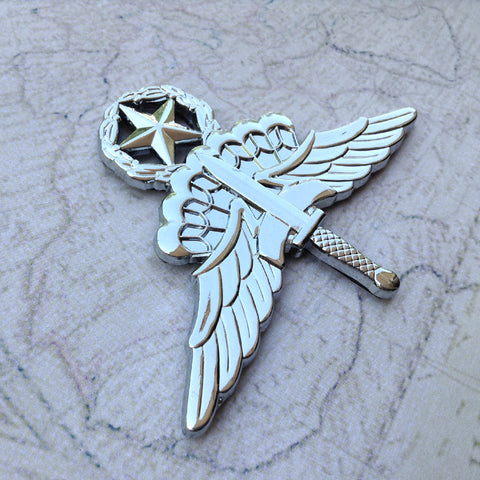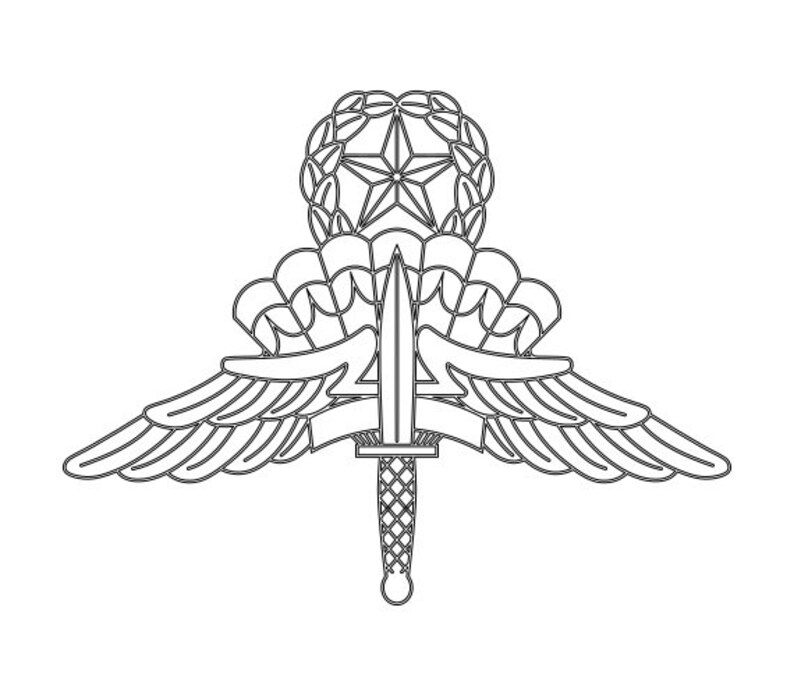

A soldier who wanted this skill badge needed 65 jumps, including four night jumps and 25 descents with combat equipment. At the same time, the Army created the Master Parachutist Badge, which was identical to the Basic and Senior badges except that a wreath surrounds the five-pointed star atop the canopy. This badge requires 30 jumps, 15 of which must be with combat equipment. The Senior Parachutist Badge, first announced in regulations in January 1950, is identical to the basic badge except for a five-pointed star atop the parachute canopy. In 1949, the Army created two new badges in response to the increase in airborne operations. In the late 1940s, for example, the 11th Airborne Division, then in occupied Japan, conducted its own parachute and glider training. When not enough soldiers volunteered for airborne training, the Army forcibly assigned men to airborne units and made these units operate their own airborne schools. Army first began asking for volunteers for airborne units, African-American soldiers were sent to the racially segregated 555th. Members of the 555th Parachute Infantry Battalion “triple nickel” are briefed before takeoff from Fort Dix, N.J. As the Army was still racially segregated, white soldiers went to jump school at Fort Benning, while African-American soldiers went to the 555th Airborne Infantry Battalion, the “triple nickel” unit, at Fort Bragg, N.C.

In 1946, the Army began asking for volunteers for airborne units. Even in 1943, when pay went up to $50 a month for a private, receiving an extra $50 jump pay meant double pay.

This was a significant amount of money, since a private (E-1) made $21 a month in 1942. The parachutist badge first appears in Army regulations as authorized for wear in November 1941.ĭuring World War II, airborne-qualified officers received $100 per month and enlisted paratroopers $50 in incentive pay. In later years, Yarborough (1912-2005) reached three-star rank and was a key figure in the Army’s Special Forces, or Green Berets. To prevent unauthorized copying of the badge, Yarborough also obtained a patent for the design of the badge, number 134,963, on Feb. Yarborough “then went to Bailey, Banks, and Biddle, the Philadelphia jeweler, which made the first 350 parachutist badges.” The badges were then produced in record time: the commander of the 501st Parachute Battalion had them in hand less than a week later. He “sketched a design that was formally approved by the War Department on March 10, 1941,” Emerson said. Emerson, a retired Army lieutenant colonel and expert on badges and insignia, the idea for the parachutist badge came from then-Capt. Army airborne parachutist badge is unchanged since its creation in 1941. Goodman was a graduate of a wide range of schools, which include advanced reconnaissance and target analysis training, an advanced urban combat course and a course to operate small unmanned aerial drones.The basic U.S. He rejoined 3rd Group’s 2nd Battalion in July 2018 and made master sergeant exactly one year later. In 2016, he became a senior instructor and later a chief instructor at 1st Special Warfare Training Group at Fort Bragg. Goodman returned to active duty and joined 3rd Group in 2010. Goodman was then assigned to 2nd Battalion, 19th Special Forces Group, a Guard unit with detachments in multiple states. He graduated from the Special Forces Qualification Course in October 2007. In 2005, he joined the Army National Guard and began training to become a Green Beret. He joined the Army in July 2002, completing basic training, advanced individual training and static-line parachute school at Fort Benning, Georgia, before reporting to 1st Battalion, 27th Infantry Regiment at Schofield Barracks, Hawaii. Goodman was born in Pasadena, California and grew up near Chicago, Illinois.


 0 kommentar(er)
0 kommentar(er)
